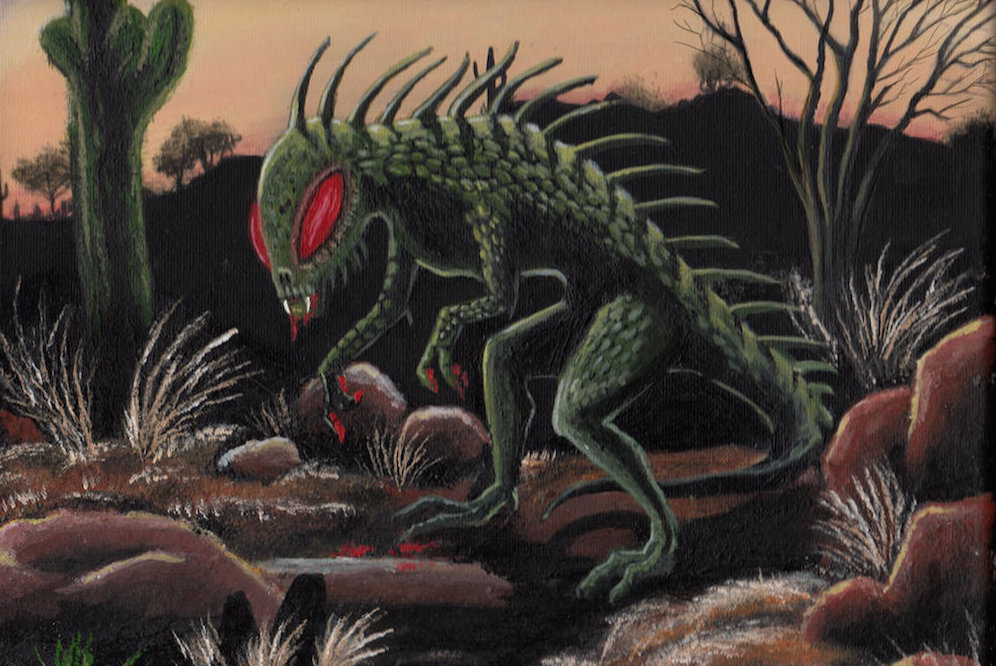Footnotes:
You know what really gets my goat? El Chupacabra. Vampire scourge to livestock owners in Latin America and the southern United States. Is the chupacabra an alien? A Caribbean man-reptile? Some kind of hairless Texan dog? Would you believe that it’s only about 21 years old? Today, we track the legend of the Goat Sucker back to the start.
On this roundtable episode, I am joined by David Gimnich of the Sidekicked pomecast as well as a personal friend of mine, Nathaniel Collins Léon, who grew up in Puerto Rico where the Chupacabra mythos was born. Something that we determined right away on the show is that there’s no true consensus as to what the Chupacabra actually looks like. Depending on who you ask, though, the chupacabra may be narrowed down to one of two forms:
The traditional chupacabra is a greenish, bipedal, somewhat reptilian creature reported to have slanted black or red eyes, fangs, claws, and spikes down its back.

However, the early to mid-2000’s saw the rise of a second, very different contender for the name. The Texas Chupacabra, as it is often referred to since this is the area where it is most commonly reported, is a medium to large canid. The creature is often described as being bluish gray in color, mostly hairless save for perhaps a ridge of hair along the back, and having two large, protruding fangs.

The Texas Chupacabra
The canid version of the chupacabra actually originates in Nicaragua in the year 2000 and travels northward toward the United States, and it’s a story that plays out virtually the same way every time: A rural community or single individual loses a large number of livestock to a single, unseen predator. The creature is eventually killed or found dead, and appears to be a discolored, monstrous canid. Having discovered an unidentifiable animal that seems to favor livestock, whoever managed to bag the animal assumes it must be the legendary chupacabra.
Once the media gets wind of the story, reports circulate on a local, national, and in some cases international level, cementing the canid variant as the definitive chupacabra. Texas has been no stranger to news reports of chupacabras: first with the Elmendorf Beast, then later the Blanco, Lake Bridgeport, and El Paso creatures.

Perhaps the most famous Texas Chupacabra incident, however, was the Cuero, Tx occurrence:
Dr. Phylis Canion discovered not one, but two mystery canid corpses on and around her property in 2007:

Here’s a closer look at the dashcam footage those two officers caught in the video above:
In every case so far, the alleged chupacabra has been revealed, often through DNA testing, to be a coyote, feral dog, or sometimes raccoon, with a severe case of sarcoptic mange. Indeed, looking at the bodies in the photos, it may seem obvious that we’re looking at mangy animals. But before we judge those who report seeing these “chupacabras” too harshly, have a look at this living example:
https://www.youtube.com/watch?v=gaS2p8VEfj4
At first glance, it appears to be a small dog. But if you look closely, it seems to be using its little hands, so maybe it’s a raccoon? If so, it’s got even experienced raccoon hunters fooled.

Note the missing front teeth in the taxidermied specimen above, giving the appearance of prominent vampiric fangs. You can start to see how a lack of expected features and a presence of unexpected features would have even experts wondering if it truly is the Goat Sucker.

The Classic Chupacabra
So that explains the Blue Dogs, but what about the original chupacabra? The real deal?
Contrary to popular belief, the chupacabra doesn’t originate in Mexico. The first reports of the creature actually come from Puerto Rico. Although many people assume the creature has been part of Latin American mythology for generations, the chupacabra actually appears in the records quite suddenly in 1995.

As Nathan points out in the episode, Puerto Rico has its own history of livestock attacks dating back to at least the 70’s. Up until 1995, however, these were largely attributed to a creature known as El Vampiro de Moca.

The Moca Vampire was a creature said to kill livestock by leaving two puncture wounds in the neck, and slash marks all over the body. Theories ranged from feral dogs to an actual vampire, but the killings eventually died down and news reports faded away.

In late 1994 through 1995, a rash of livestock deaths broke out across the island, and talk of El Vampiro de Moca surfaced once again. Then, in August 1995 in the town of Canovanas where over a hundred animals were said to have fallen victim, a woman by the name of Madelyne Tolentino claimed to have seen the creature responsible.
I found a transcript of UFO Digest’s famous interview with Madelyne Tolentino on their website, but be warned, there’s instant pop-ups and page redirection. You can read the transcript over at UFO Digest. Or if you prefer, I have also put together a pdf copy for your convenience.
The name “El Chupacabras” came later, and is often credited to the Puerto Rican comedian Silverio Perez. Tabloids picked up the name as well as Madelyne Tolentino’s story and ran with the ideas. It’s important to note that the original interview with Tolentino was conducted by UFO investigators, not journalists. The story was mainly reported within Purto Rico by El Vocero and other tabloid papers that are equivalents to the Weekly World News, but reported in the continental Americas by mainstream journalism.

But even the first reports of the chupacabra are a far cry from the descriptions of its predecessor El Vampiro de Moca, which was at times described as a bat or even an enormous carnivorous bird. Madelyne Tolentino’s description of the chupacabra details a creature that lands somewhere between an alien and a lizard, appearance-wise.

Was there truly a creature out there that fit this gruesome visage? Or was there some other inspiration for the account that Madelyne Tolentino gave? Here’s a hint:


Sources:
La Historia del Vampiro de Moca (1975) by Javier R. Almeyda-Loucil
1975, February~July: The Vampire of Moca
Mystery Creature Ravages Puerto Rican Livestock by Karl Ross (1995)
Johnny Depp dice luchó por horas contra “el chupacabras” by Leer Luego
Species Official Movie Trailer
Original Scans: El Vocero’s Vampiro de Moca coverage.
El Chupacabra Mystery Solved: Case of Mistaken Identity by Bjorn Carey
Texas State University Researcher Helps Unravel Mystery of Texas ‘Blue Dog’ by BioNews Texas
Tracking the Chupacabra: The Vampire Beast in Fact, Fiction, and Folklore by Benjamin Redford
Museum Management:
Museum theme by Michael Guy Bowman
Listen to more at: bowman.bandcamp.com
Rachel: Designer #UkuleleWitch @rachelvice
Tour Guides: Emery Coolcats, Nathaniel Collins Léon, David Gimnich
Twitter: @natmysterycast | Email: natmysterypodcast@gmail.com | Home: pome-mag.com/category/pomecast
Follow the show on iTunes or Soundcloud!
Museum of Natural Mystery is part of the POMEcast network, and thanks a million to the ladies of POME for helping this show get up and running! But above all, thank you for listening! We’ll see you next time!




